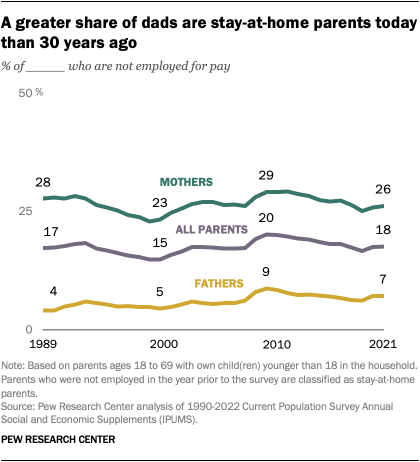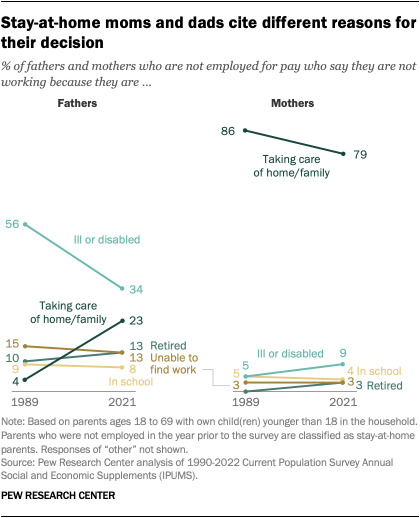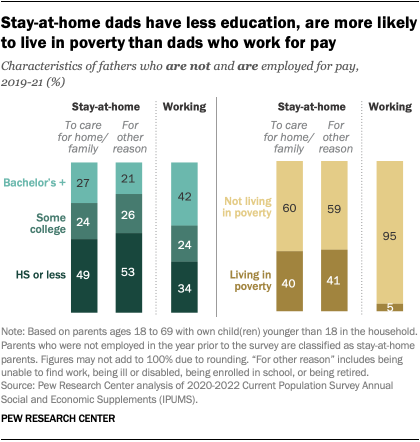
Pew Research Center conducted this analysis to see how many mothers and fathers in the United States are not employed for pay and how stay-at-home parents are different from working parents. The analysis uses the Annual Social and Economic Supplement (ASEC) of the Current Population Survey (CPS), which is conducted in March of every year.
Administered jointly by the U.S. Census Bureau and the Bureau of Labor Statistics, the CPS is a monthly survey of approximately 70,000 households. It is the source of the nation’s official statistics on unemployment. The ASEC survey typically features an expanded sample of about 95,000 households.
Parents are people ages 18 to 69 who live with at least one of their own children (biological, step or adopted) younger than 18. Stay-at-home parents are those who were not employed for pay at all in the calendar year prior to the survey.
The population of stay-at-home fathers who are caring for home or family is relatively small, so we combined the 2020, 2021 and 2022 ASEC files to analyze their characteristics.
The share of parents in the United States who are not employed for pay has been fairly stable over the last five years. In 2021, 18% of parents didn’t work for pay, which was unchanged from 2016, according to a new Pew Research Center analysis of U.S. Census Bureau data. The share who are stay-at-home parents differs between men and women: 26% of mothers and 7% of fathers.

Over the past 30 years, the share of stay-at-home parents has fluctuated, rising during periods of higher unemployment.
How stay-at-home dads and moms compare
Between 1989 and 2021, the share of mothers who were not employed for pay decreased slightly, from 28% to 26%. Over the same span, the share of fathers who were not working increased from 4% to 7%.
Due to these diverging trends, dads now represent 18% of stay-at-home parents, up from 11% in 1989.

The reasons mothers and fathers give for not working for pay differ significantly. In 2021, the vast majority of stay-at-home moms (79%) said they took care of the home or family. About one-in-ten (9%) said they were at home because they were ill or disabled, and smaller shares said they didn’t work because they were students, unable to find work or retired.
Stay-at-home dads cite more varied reasons for not working for pay. In 2021, 23% stayed home to care for the home or family. That is up from only 4% in 1989 but still well below the share of stay-at-home moms who said the same.
About one-third of stay-at-home dads (34%) were not working due to illness or disability, down from 56% in 1989. Some 13% were retired, 13% said they could not find work and 8% were going to school.
How stay-at-home dads are different from dads who work
Stay-at-home dads differ demographically from dads who work for pay.

- Education: Stay-at-home dads are less likely than dads working for pay to have completed at least a bachelor’s degree. Some 22% of stay-at-home dads have this level of education, compared with 42% of dads who work for pay.
- Poverty: The families of stay-at-home dads tend to be less economically well-off than the families of dads who work for pay. Some 40% of stay-at-home dads live in poverty, compared with 5% of dads who work for pay.
- Age: Stay-at-home dads tend to be older than dads working for pay. Some 46% of stay-at-home dads are age 45 or older, compared with 35% of dads working for pay.
- Race and ethnicity: Stay-at-home dads are a more racially and ethnically diverse group than working dads. Half of dads who don’t work for pay are non-Hispanic White. This compares with 60% of dads working for pay. Non-Hispanic Black fathers are a larger share of stay-at-home dads (18%) than they are of working dads (9%). Hispanic fathers are 21% of both stay-at-home and working fathers, and non-Hispanic Asian fathers are 7% of stay-at-home fathers and 8% of working fathers.
- Marriage: Some 68% of stay-at-home dads are married, as are 85% of dads who work for pay.
In addition, stay-at-home dads who are taking care of the home or family differ in some ways from those who stay home for other reasons.
- Education: 27% of dads who stay home to care for family have a four-year college degree, while 21% of dads who stay home for other reasons do.
- Age: A third of dads staying home to take care of family are age 45 or older, compared with half of those who are home for other reasons.
- Marriage: 73%of dads who stay home to care for family are married, as are 66% of dads who are home for other reasons.
Note: This is an update of a post originally published Sept. 24, 2018, written by former Senior Researcher Gretchen Livingston.
